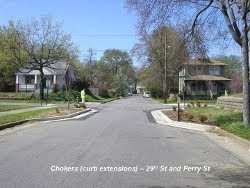Automobile traffic dominates the built environment of our urban cities. It not only rules the road by means of infrastructure, but also with the weight and velocity of its many parts. With the infrastructure green light (pun!) and the freedom to careen at unmatchable speeds, the United States road is discriminating and an overall attack on non-motorize accessibility. Some may argue that the roads are made for cars, thus you do not witness the automobile infiltrating sidewalks or bike lanes. It is true that the road was primarily designed for the car, though carbon-neutral and more vulnerable modes must safely access them as well. The path of the automobile is pervasive and crosscutting, marginalizing all other forms of transportation such as walking, wheeling, and biking.
Traffic calming, which is “the process of slowing down traffic so that street environment is safer and more conducive to pedestrians, cyclists, shoppers, and residential life,” is mostly implemented through physical alteration of roadways (Newman and Kenworthy, as cited in Wheeler and Beatley). The notion of traffic calming is inherently at odds with many daily commuters. These calming measures can add to congestion and travel time for motorists. Although the measures seem like an attack on the personal automobile and other motorized vehicles, they are simply making the streets safer and more appropriate for non-motorists. This leveling of the playing field may further inconvenience for drivers, but it certainly enables the convenience of other modes.
In the name of accessibility, here are some of the ways that transportation planners are developing strategic designs to calm the incessant buzz of traffic in our communities:
Textured Pavement
Source: Construction Photography
Chicane (or S-Shaped Diverter)
Source: Richard Drdul, Flickr
Neck-Down (or Choker)
Source City of Richmond
Speed Bump (or Speed Hump)
Source: City of Lynnwood
Bulb-Out
Source: Calm Streets Boston
Other traffic calming tools and methods include adding bike lanes, narrowing the number of street lanes, and simple landscaping designs (e.g., planting trees on roadsides). The following video further describes common traffic calming measures:
According to Newman and Kenworthy, slowing traffic with the use of traffic calming mechanisms has many benefits: reduction in traffic accidents, better air quality, less noise pollution, increased sense of community, and decrease crime rates.
Unfortunately, traffic calming measures are not flawless. There are also a number of disadvantages associated with these structures. Traffic congestion and public outcry can result if the municipal governments that implement the measures do not effectively socially market the new barriers. Unaware drivers are likely to make illegal moves and endanger the lives pedestrians and cyclists (e.g., veering into bike lanes). The demand for personal automobile use will rise during the winter season and regular adverse conditions, and traffic calming measures can catalyze congestion. Also if the calming measures are not widely implemented traffic will simply be diverted to other roadways. Lastly, as discussed in class, emergency vehicles can be delayed due to measures such as speed bumps, endangering public safety. The following video touches upon that point:
Personally, I am a big fan of traffic calming. It makes drivers more aware and allows them to operate their vehicles at a safe speed. I do not believe, however, that traffic calming is a sole solution to accessibility. Traffic calming should be couple with other transportation measures such as 4-6 ft. wide sidewalks and efficient public transit.
In my neighborhood in Indianapolis, there was a controversial traffic calming scheme put into place on 62nd Street, a four-lane roadway going in and out of Broad Ripple Village. For those of you unfamiliar with Indianapolis, Broad Ripple Village is an area akin to Kirkwood Avenue, a cultural hub lined with bars, boutiques, and restaurants. Members of the public approached The Indianapolis Office of Sustainability to scale 62nd Street from a four-lane street to a two-lane street with the addition of two bike lanes, one on each side of the street. After months of construction, the street was narrowed and the bike lanes were complete. What you think would have been a celebratory moment for my neighborhood turned into communal backlash. According to Kristen Trovillion of The Office of Sustainability, the Department of Public Works received frequent complaints for weeks. Traffic was backed up for blocks. Drivers did not understand how to navigate the road without veering into the bike lanes. It was a mess. Eventually, the area learned to live with the lanes, but not without a struggle.
It is funny how sustainability measures can sound great on paper, but when implemented in communities, neighbors tend to backlash at the reality of the change. The reality is that the future of sustainability holds a world of sacrifice, and our readiness and willpower to change our habits is very important.






